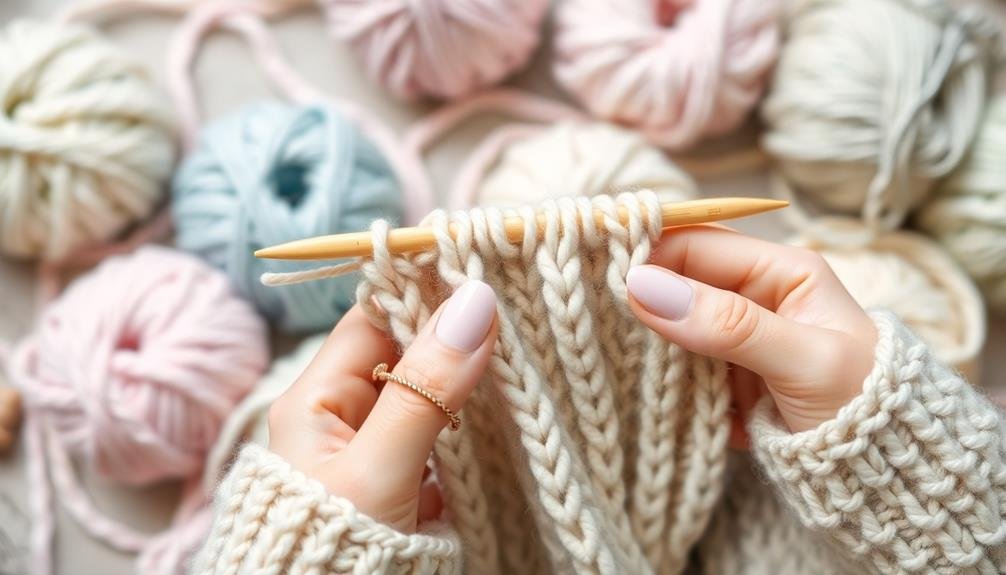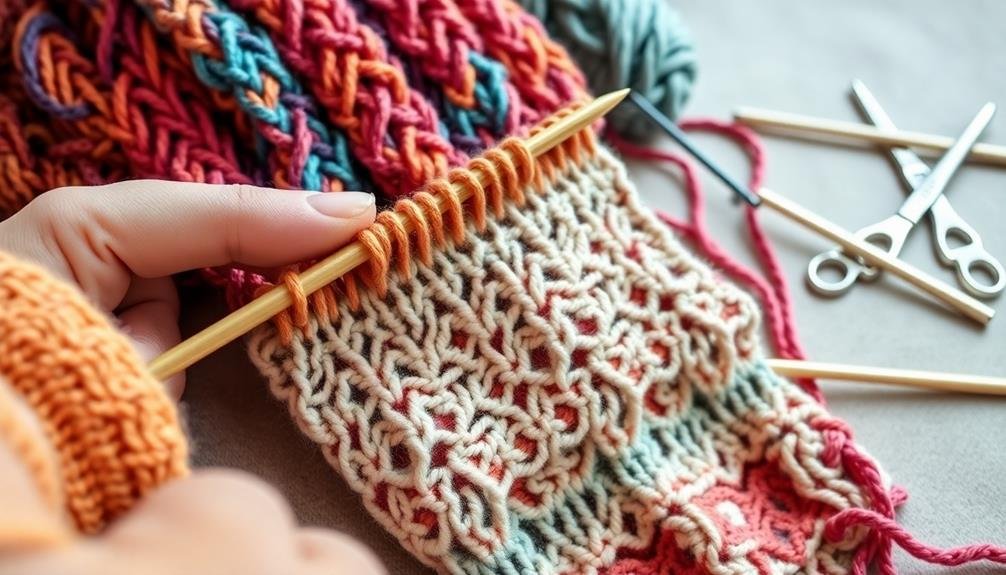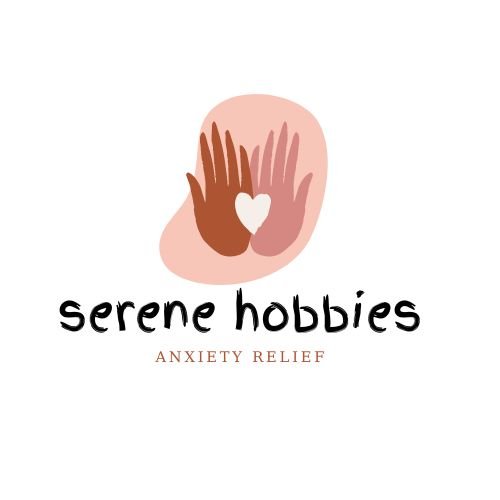Knitting patterns ease stress at every level by engaging your mind and body in a soothing, rhythmic activity. As a beginner, you'll find calm in simple, repetitive stitches. Intermediate knitters can lose themselves in more complex patterns, providing a focused distraction from daily worries. Advanced projects challenge your problem-solving skills, boosting cognitive flexibility. Regardless of skill level, you'll experience the satisfaction of creating tangible results, building confidence and self-esteem. Knitting also offers opportunities for social connection and creative expression. Whether you're casting on your first stitch or tackling an intricate design, there's a stress-relieving benefit waiting for you in every pattern.
Beginner Patterns: Simple Stress Relief

Simplicity is key when starting your knitting journey for stress relief. As a beginner, you'll want to focus on basic patterns that allow you to develop your skills without overwhelming you. Start with a simple scarf or dishcloth project using basic knit and purl stitches. These repetitive motions can help calm your mind and reduce anxiety.
Try a garter stitch scarf, which uses only the knit stitch. This pattern is perfect for beginners and provides a soothing, rhythmic activity. Another option is a seed stitch dishcloth, combining knit and purl stitches in an easy-to-remember pattern. Both projects offer quick results, boosting your confidence and providing a sense of accomplishment.
As you progress, consider simple hat patterns or a basic blanket square. These projects introduce new techniques like decreasing or working in the round, gradually expanding your skills without causing stress.
Remember to choose soft, easy-to-work-with yarns in colors you love. This will make your knitting experience more enjoyable and increase its stress-relieving benefits. Don't worry about perfection; focus on the process and the calming effect of creating something with your hands.
Meditative Repetition in Basic Stitches
When you knit basic stitches, you'll find the rhythmic motion naturally calms your mind.
As you focus on each stitch, you're drawn into the present moment, leaving worries behind.
This stitch-by-stitch approach becomes a mindfulness practice, offering a meditative experience with every row you complete.
Rhythmic Motion Calms Mind
The rhythmic motion of knitting basic stitches can transport you into a meditative state, calming your mind and reducing stress. As you repetitively move your needles and yarn, you'll find your thoughts slowing down and your focus narrowing to the task at hand. This rhythmic action engages your body and mind in a soothing, predictable pattern that can lower your heart rate and blood pressure.
When you're knitting, you're creating a steady tempo with your hands. This consistent rhythm activates the parasympathetic nervous system, which is responsible for the body's rest and digest response. As a result, you'll experience a decrease in cortisol levels and an increase in feel-good neurotransmitters like serotonin and dopamine.
The repetitive nature of knitting also promotes a state of flow, where you're fully immersed in the activity. This state of absorption can help you temporarily forget about daily worries and stressors.
Focus on Present Moment
This meditative quality of knitting extends beyond just the rhythmic motion, encompassing the focus required for basic stitches. As you work on a pattern, you're forced to concentrate on the present moment, counting stitches and following instructions. This intense focus acts as a form of mindfulness meditation, pulling your attention away from worries and stress.
When you're knitting, you can't dwell on past mistakes or future anxieties. You must remain in the here and now, fully engaged with each stitch. This present-moment awareness is a key component of stress relief and mental well-being. It's similar to the benefits you'd get from formal meditation practices, but with the added bonus of creating something tangible.
Even simple patterns require your full attention. You'll find yourself completely absorbed in the task, losing track of time and external concerns. This state of flow, where you're fully immersed in an activity, is known to reduce stress and increase overall happiness.
Stitch-by-Stitch Mindfulness Practice
Basic knitting stitches offer a perfect opportunity for stitch-by-stitch mindfulness practice. As you work on simple patterns, you can focus your attention on each individual stitch, observing the movement of your hands and the formation of the fabric. This repetitive process allows you to enter a meditative state, where you're fully present in the moment.
When you're knitting, pay attention to the sensations in your fingers as they manipulate the yarn and needles. Notice the texture of the yarn, the click of the needles, and the rhythm of your movements. As thoughts arise, acknowledge them without judgment and gently return your focus to the stitches.
You can use each stitch as a breath anchor, synchronizing your breathing with the knitting motion. Inhale as you insert the needle, exhale as you wrap the yarn, and so on. This practice helps calm your mind and reduces stress by keeping you anchored in the present.
Intermediate Challenges: Focused Distraction

Have you ever found yourself so engrossed in a knitting project that you've forgotten your worries? That's the power of focused distraction, and it's especially potent when you tackle intermediate-level knitting patterns. These challenges demand just enough attention to keep your mind occupied without overwhelming you.
As you progress beyond basic stitches, you'll encounter more complex techniques like cable knitting, lace work, or colorwork. These patterns require concentration, forcing your brain to shift gears from daily stressors to the task at hand. You'll count stitches, follow charts, and make calculated decisions about tension and yarn placement. This level of engagement acts as a form of active meditation, allowing you to enter a flow state where time seems to melt away.
Intermediate projects also offer a sense of accomplishment as you master new skills. The satisfaction of completing a challenging pattern boosts your confidence and provides a tangible reminder of your capabilities.
Accomplishment Through Gradual Skill Building
You'll find that knitting offers a path to accomplishment through gradual skill building.
As you master simple techniques and move on to more complex patterns, you'll see visible progress that motivates further learning.
Your confidence will grow as you tackle incremental challenges, allowing you to take on increasingly sophisticated projects over time.
Mastering Simple to Complex
Knitters often find that mastering increasingly complex patterns provides a sense of accomplishment and personal growth. As you progress from simple scarves to intricate lace shawls, you'll experience the thrill of conquering new techniques and stitches. This gradual skill-building process not only enhances your knitting abilities but also boosts your confidence and reduces stress.
Start with basic patterns and work your way up to more challenging projects. Each completed item serves as a tangible reminder of your progress and dedication. You'll find that tackling complex patterns becomes less intimidating as you build upon your foundation of skills.
| Skill Level | Project Examples | Stress-Relief Benefits |
|---|---|---|
| Beginner | Scarves, Dishcloths | Builds confidence |
| Intermediate | Hats, Socks | Improves focus |
| Advanced | Sweaters, Cables | Enhances problem-solving |
| Expert | Lace, Fair Isle | Boosts creativity |
| Master | Original Designs | Provides deep satisfaction |
As you progress through these levels, you'll notice how knitting becomes a meditative practice, allowing you to enter a flow state and forget about daily stressors. Embrace the journey from simple to complex patterns, and watch your skills and stress-relief abilities grow simultaneously.
Visible Progress Motivates Learning
Seeing tangible progress in your knitting projects can be a powerful motivator for continued learning and skill development. As you work through patterns of increasing complexity, you'll witness your creations taking shape stitch by stitch. This visible growth not only boosts your confidence but also fuels your desire to tackle more challenging designs.
Start with simple scarves or dishcloths, where you'll quickly see results. As you master basic stitches, move on to more intricate patterns like cable knits or lace work. Each completed row brings you closer to your finished product, providing a sense of accomplishment that counters stress and anxiety.
Set achievable goals for yourself, such as learning one new technique per project. This approach allows you to build your skills gradually while maintaining a steady sense of progress.
Document your journey by taking photos of your work at different stages. You'll be amazed at how far you've come when you look back on your earlier pieces.
Confidence Through Incremental Challenges
Building confidence through knitting isn't just about seeing progress—it's about strategically challenging yourself. As you master basic stitches, you'll naturally seek more complex patterns. This gradual skill-building process allows you to tackle increasingly difficult projects without feeling overwhelmed.
Start with simple scarves or dishcloths, then move on to hats or mittens. Each new technique you learn, like cable stitches or colorwork, adds to your knitting repertoire. You'll find that skills from previous projects transfer to more advanced ones, reinforcing your abilities and boosting your self-assurance.
Don't be afraid to attempt patterns slightly beyond your current skill level. These incremental challenges push you out of your comfort zone while remaining achievable. As you overcome each hurdle, you'll experience a sense of accomplishment that fuels your motivation to continue learning.
Advanced Patterns: Problem-Solving Therapy

Advanced knitting patterns offer more than just a challenge; they serve as a form of problem-solving therapy. As you tackle complex designs, you're exercising your brain's ability to process information, make decisions, and adapt to new situations.
These skills translate directly into your daily life, helping you approach problems with a clearer, more analytical mindset.
When you're working on an intricate pattern, you'll often encounter obstacles that require creative solutions. This process of troubleshooting and overcoming difficulties can boost your confidence and resilience.
You'll learn to break down complex problems into manageable steps, a valuable skill in both knitting and life.
Here's how advanced patterns act as problem-solving therapy:
- Enhance cognitive flexibility
- Improve spatial reasoning
- Develop patience and perseverance
- Strengthen decision-making abilities
Multitasking Benefits of Complex Projects
Complexity in knitting projects offers a unique opportunity to hone your multitasking skills. As you work on intricate patterns, you'll find yourself juggling multiple tasks simultaneously. You're keeping track of stitch counts, following chart instructions, and maintaining tension, all while your hands are in constant motion. This mental and physical coordination can improve your overall cognitive function and dexterity.
Complex knitting projects also train your brain to switch between different types of focus. You'll alternate between intense concentration on detailed sections and more relaxed, repetitive motions. This mental flexibility can translate to other areas of your life, helping you manage various responsibilities more efficiently.
Moreover, tackling complex projects enhances your ability to break large tasks into manageable steps. You'll learn to approach challenges systematically, a skill that's valuable in both personal and professional settings.
The sense of accomplishment you'll feel as you complete each section of a difficult pattern can boost your confidence and motivation. By engaging in these multifaceted knitting projects, you're not just creating beautiful items; you're also developing valuable cognitive skills that can benefit you in numerous aspects of your daily life.
Social Connection in Knitting Communities

While complex knitting projects offer personal growth, they also open doors to vibrant social connections. You'll find that joining knitting communities, whether online or in-person, can greatly enhance your crafting experience. These groups provide a platform to share your progress, seek advice, and celebrate achievements with like-minded individuals.
When you participate in knitting communities, you'll:
- Expand your skillset through shared knowledge
- Find motivation and accountability for completing projects
- Develop lasting friendships based on common interests
- Discover new patterns and techniques you mightn't have encountered otherwise
You'll notice that knitting groups often organize events like yarn swaps, charity knit-alongs, and workshops. These activities not only improve your skills but also foster a sense of belonging and purpose.
As you engage with fellow knitters, you'll find yourself part of a supportive network that understands the joys and challenges of your craft.
Don't underestimate the power of social media in connecting with knitters worldwide. Platforms like Instagram and Ravelry allow you to showcase your work, follow talented crafters, and participate in global knitting challenges, further expanding your social circle and creative horizons.
Tangible Results: Anxiety-Reducing Satisfaction
As you knit stitch after stitch, you're not just creating a physical object; you're also building a sense of accomplishment that can greatly reduce anxiety. The tangible results of your knitting efforts provide a powerful antidote to stress. You'll find satisfaction in watching your project grow, row by row, until it transforms into a finished piece.
This process of creation offers a unique form of mindfulness, allowing you to focus on the present moment and push away intrusive thoughts. As you complete each section, you'll experience small victories that boost your confidence and self-esteem. The final product serves as a physical reminder of your capability and patience.
| Project Stage | Emotional Impact | Stress Relief |
|---|---|---|
| Starting | Excitement | Distraction |
| Mid-progress | Determination | Focus |
| Near completion | Anticipation | Pride |
| Finished item | Satisfaction | Achievement |
Whether it's a cozy scarf, a pair of mittens, or an intricate sweater, your knitted creation represents hours of dedication and skill. You'll feel a sense of pride every time you use or wear your handmade item, reinforcing the anxiety-reducing benefits of your knitting practice.
Customization: Empowerment Through Creativity

Knitting empowers you through its endless potential for customization. You're not limited to store-bought designs; instead, you can modify existing patterns or create your own from scratch. This creative control allows you to express your unique style and preferences, boosting your confidence and sense of accomplishment.
When you customize knitting patterns, you're engaging in a form of problem-solving that stimulates your brain and reduces stress. You'll find yourself making decisions about yarn types, colors, textures, and stitches, all of which contribute to a final product that's uniquely yours.
This process of personalization can be incredibly rewarding, as you see your vision come to life stitch by stitch.
Here's how customizing knitting patterns empowers you:
- It develops your decision-making skills
- It enhances your creativity and self-expression
- It builds confidence in your abilities
- It provides a sense of ownership over your work
Frequently Asked Questions
Can Knitting Help With Specific Mental Health Conditions Like Depression or PTSD?
Yes, knitting can help with depression and PTSD. You'll find it's a calming, repetitive activity that promotes mindfulness and reduces anxiety. It can boost your mood, improve self-esteem, and provide a sense of accomplishment and control.
How Does Knitting Compare to Other Stress-Relief Activities Like Meditation or Exercise?
You'll find knitting offers unique benefits compared to meditation or exercise. It's a hands-on activity that engages your mind and body, promotes mindfulness, and provides a tangible result. It's also more portable and can be done virtually anywhere.
Are There Any Physical Health Benefits Associated With Regular Knitting?
Yes, you'll enjoy physical health benefits from regular knitting. It can lower your blood pressure, reduce chronic pain, and improve dexterity. You'll also experience better hand-eye coordination and potentially delay the onset of dementia.
What Are the Best Yarns and Needles for Beginners to Use?
For beginners, you'll want to start with medium-weight yarn like acrylic or wool blend. Choose larger needles (US size 8-10) for easier handling. Bamboo or wooden needles are great as they're less slippery than metal ones.
Can Knitting Be an Effective Form of Occupational Therapy for Certain Conditions?
Yes, knitting can be an effective occupational therapy tool. It'll help improve your fine motor skills, hand-eye coordination, and concentration. You'll also benefit from its stress-reducing effects, making it useful for anxiety and depression management.
In Summary
You've discovered that knitting patterns offer stress relief at every skill level. Whether you're a beginner finding peace in simple stitches or an expert tackling complex designs, you're reaping the benefits of this therapeutic craft. As you progress, you'll experience focused distraction, problem-solving, and a sense of accomplishment. Don't forget the social connections and creative empowerment that come with knitting. So pick up those needles and start stitching your way to a calmer, more satisfied you.





Leave a Reply